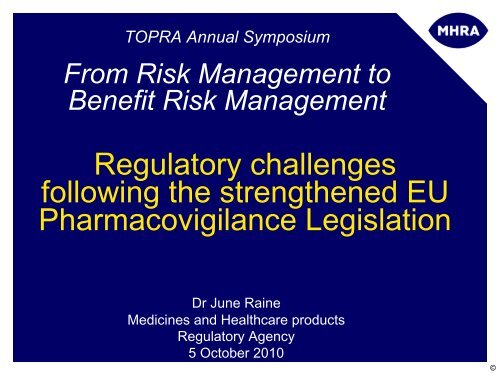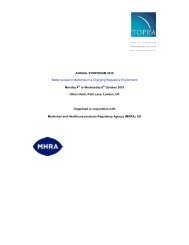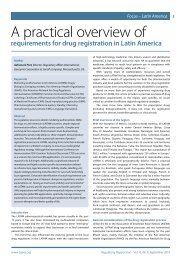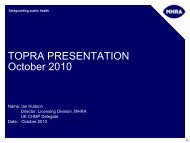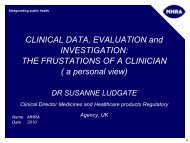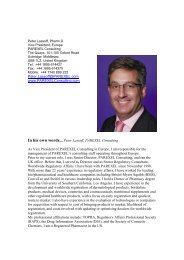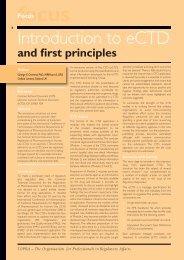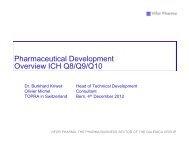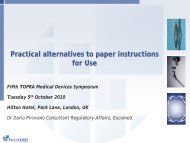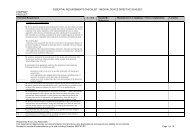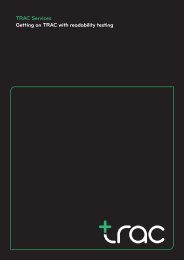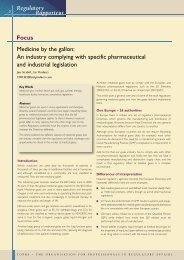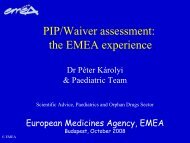MHRA powerpoint template - TOPRA
MHRA powerpoint template - TOPRA
MHRA powerpoint template - TOPRA
Create successful ePaper yourself
Turn your PDF publications into a flip-book with our unique Google optimized e-Paper software.
<strong>TOPRA</strong> Annual Symposium<br />
From Risk Management to<br />
Benefit Risk Management<br />
Regulatory challenges<br />
following the strengthened EU<br />
Pharmacovigilance Legislation<br />
Dr June Raine<br />
Medicines and Healthcare products<br />
Regulatory Agency<br />
5 October 2010<br />
©
Agenda/Objectives<br />
• What is context for the new European<br />
pharmacovigilance legislation?<br />
• What are key regulatory challenges<br />
following strengthened EU legislation ?<br />
• How to move from risk management to<br />
benefit risk management?<br />
©
Context for the new EU<br />
Pharmacovigilance legislation<br />
©
The problem…<br />
©
Historical perspective<br />
A European Commission<br />
review in 2004 found……<br />
• Unclear roles and<br />
responsibilities<br />
• Complex ADR reporting rules<br />
• Differences at member state<br />
level<br />
• Complex decision making<br />
procedures<br />
• Lack of robust safety studies<br />
©
Goals of EU Pharmacovigilance<br />
legislative revision<br />
Strengthening and rationalizing<br />
the community pharmacovigilance<br />
system, with overall objectives of:<br />
• Better protection of public<br />
health<br />
• Ensuring proper functioning of<br />
the internal European market<br />
• Simplification of current rules<br />
and procedures<br />
©
Where are we now?<br />
• Final text for legislation agreed by<br />
Parliament and Council on 23 June 2010<br />
• Final voting at European Parliament<br />
22nd September 2010<br />
• Publication expected Q1 2011.<br />
- 18 additional months for transposition<br />
©
Commission, Council, Parliament<br />
©
"Enhancing our capacity to detect and collect<br />
adverse drug reactions across the EU, as well as<br />
better coordination with national authorities and<br />
pharmaceutical companies, is a key step towards<br />
making sure risks related to the use of medicinal<br />
products are highlighted in a timely manner and duly<br />
assessed…<br />
“More transparent communication about<br />
pharmacovigilance activities, together with a more<br />
efficient overall system at EU level, will enhance<br />
patients' trust in the medicines they are taking, as<br />
well as in the authorities that guarantee their safety",<br />
©
Key regulatory challenges<br />
following new EU legislation<br />
©
Key regulatory challenges<br />
•New committee set up<br />
•Signal detection<br />
•Worksharing of PSURs<br />
•Decision-making processes<br />
•Transparency<br />
•Post authorisation efficacy studies<br />
©
PV Risk Assessment Committee<br />
Mandate – key role<br />
initial analysis of signals<br />
PSURs and PASS,<br />
agreement of risk<br />
management systems<br />
pharmacovigilance risk<br />
assessments<br />
therapeutic context<br />
Status of PRAC advice<br />
Recommendations to CHMP<br />
and CMDh to be respected, if<br />
not explanation to be given<br />
©
Signal detection<br />
• Wider scope of AR definition:<br />
implications for collection and<br />
database management<br />
• MAH reports direct to<br />
Eudravigilance when meets<br />
functional specifications<br />
• Electronic reporting via<br />
standard form<br />
• Patient reporting<br />
©
Eudravigilance signal function<br />
•Direct evidence that >54%<br />
serious safety issues can be<br />
detected earlier if Eudravigilance<br />
used in addition to other<br />
pharmacovigilance resources<br />
•Analysis of pooled data<br />
Detection of rare ADRs<br />
Earlier as absolute<br />
numbers are greater<br />
Drug Safety 33(6) 475-487<br />
©
Additional monitoring<br />
• New active substances<br />
• New authorisations of biological<br />
products (including biosimilars)<br />
• Plus any other, on request of<br />
NCAs (+PRAC) for products with<br />
specific requirements in RMP<br />
▼<br />
• Specific symbol and text in SPC,<br />
PIL<br />
• 5 years or once conditions met,<br />
whichever last<br />
©
Worksharing of PSURs<br />
• PSUR (routine) waivers: generics, herbals, but not<br />
for hybrids and informed consent<br />
• No waiver if justified by NCAs +PRAC:<br />
- PhV concern, innovator out of the market.<br />
• Assessment report to be adopted by CHMP or CG<br />
only in case of proposed changes to MA conditions<br />
©
Current PSUR worksharing<br />
Allocated P-RMS for PSUR Work-Sharing<br />
80<br />
70<br />
69<br />
60<br />
50<br />
40<br />
30<br />
20<br />
10<br />
0<br />
56<br />
50<br />
47<br />
41<br />
34<br />
31<br />
25<br />
26<br />
22<br />
20<br />
18 17<br />
16 17<br />
12<br />
12<br />
7<br />
7<br />
4 4<br />
3<br />
1<br />
1<br />
AT BE BG CY CZ DE DK EE EL ES FI FR GR HU IE IS IT LI LT LU LV MT NL NO PL PT RO SE SI SK UK<br />
Member State<br />
©
Decision-making procedures<br />
• Two procedures as result of PhVig<br />
data, depending on urgency:<br />
- Article 31<br />
- Article 107i (urgent procedure)<br />
• To be applied to all products (inc<br />
centrally authorised) when<br />
authorised in more than 1 MS<br />
• Possibility of public hearings:<br />
general principles, PRAC decides,<br />
future EMA guidelines.<br />
©
Transparency & Communication<br />
• EMA to set up and maintain<br />
European medicines web portal<br />
• Summary of committee meetings<br />
regarding PhVig activities<br />
• Risk management plans<br />
• List of medicines under<br />
additional monitoring<br />
• Initiation of safety procedures<br />
©
Post authorisation efficacy<br />
studies<br />
• Duly justified requirement from<br />
competent authorities<br />
• At the time of the granting of MA or<br />
later, different scenarios:<br />
- Data that can only be obtained<br />
after MA grant<br />
- Scientific/methodological advances<br />
• Further elaboration on different<br />
situations where PAES required<br />
©
Moving from risk management<br />
to benefit risk management<br />
©
Regulatory evolution<br />
3. Proactive benefit risk<br />
management, throughout<br />
product life cycle<br />
1. Risk detection<br />
Individual case reports<br />
2. Risk management<br />
–pharmacovigilance plans,<br />
risk minimisation<br />
1980s 2005 2010<br />
22<br />
©
Moving from RMP to BRMP<br />
• What have we learnt so far?<br />
- experience with PASS and RMPs<br />
- advanced therapy medicines<br />
• Updating RMP Guidelines<br />
• New methodologies, research capacity<br />
• International perspectives<br />
• Communication challenges<br />
©
Example - sibutramine<br />
NEJM,<br />
2010,<br />
Sept 2<br />
James<br />
et al<br />
©
Experience with RMPs<br />
Giezen et al 2009<br />
Drug Safety 32(12) 1175<br />
©
Updating of RMP Guideline<br />
• Modular approach<br />
• Incorporate efficacy<br />
guidance<br />
• Active substance based<br />
• Draft by end 2010<br />
©
B:R management - challenges<br />
• Access to robust evidence on<br />
emerging risk in post authorisation<br />
phase<br />
• Good data on how medicine is<br />
being used in practice<br />
• Good data on background rates in<br />
exposed population<br />
• Time dimension – evolving<br />
evidence throughout life cycle<br />
• Benefit risk not (well) quantified at<br />
time of authorisation<br />
©
Innovative Medicines Initiative<br />
Public Private Partnership<br />
PROTECT Pharmepi<br />
Research on Outcomes<br />
of Therapeutics by EU<br />
ConsorTium<br />
Work packages looking at<br />
innovative methods,<br />
including integration of<br />
data on benefit risk and<br />
graphical representation<br />
©
• ENCePP = European Network of<br />
centres for Pharmacovigilance and<br />
Pharmacoepidemiology<br />
• Aim is to facilitate conduct of highquality,<br />
multi-centre, independent<br />
post-authorisation studies<br />
focussing on safety and benefit:risk<br />
• 90 centres, plus specialist networks<br />
©
The benefits of ENCePP will be:<br />
• To identify, characterise and<br />
promote access to PhVig /<br />
PhEpi resources in Europe<br />
• Improve research standards<br />
• “ENCePP seal”<br />
• Increase independence and<br />
transparency in research<br />
• Stimulate collaboration and<br />
exchange of information and<br />
experience<br />
©
International perspectives<br />
“There is no defined and tested algorithm or<br />
summary metric that combines benefit and risk and<br />
that might permit straightforward quantitative<br />
comparisons of different treatment options which in<br />
turn might aid in decision making”<br />
CIOMS Working Group IV<br />
“Benefit - Risk<br />
Balance for<br />
Marketed Drugs:<br />
Evaluating<br />
Safety Signals”<br />
©
CIOMS Working Group IX<br />
On practical considerations for development and<br />
application of a toolkit for medicinal product risk<br />
management<br />
“CIOMS IX plans to develop a pragmatic consensus<br />
guideline to be used by industry and regulators …<br />
A harmonised list of tools for managing risks of<br />
medicinal products which can be applied globally, as<br />
well as potential application of these tools”<br />
April 2010<br />
©
B:R communication challenges<br />
• Better ways of expressing benefit risk<br />
• Greater lay and patient involvement in processes<br />
• Public education on benefit risk<br />
©
Active communication of benefit risk<br />
PRESS RELEASE<br />
CHMP concluded that the<br />
benefits of Thalidomide<br />
outweigh its risks for treatment<br />
of multiple myeloma….<br />
Clinical studies have shown that<br />
adding Thalidomide can prolong<br />
survival time by about 18 months<br />
in newly-diagnosed multiple<br />
myeloma patients over 65 years<br />
of age as compared to patients….<br />
©
Summary<br />
• New EU Pharmacovigilance legislation<br />
will strengthen and simplify systems –<br />
sound rationale and public health goal<br />
• New legislation creates challenges,<br />
opportunity to move to benefit risk<br />
management<br />
• Better methodologies and tools are<br />
needed, and better public<br />
communication of benefit risk is key to<br />
moving forward<br />
©


